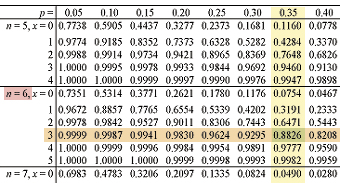Home >>STATISTICS, Section 2, binomial distribution 3
first principles |
First Principles
UNDER CONSTRUCTION AT PRESENT
Cumulative probability tables - case of p<0.5
These give the tabulated value of P(X< x) . This means that the probability displayed is less than or equal to an observed value of x.
The random variable X is distributed Binomially, where there are n trials and probability of success p .
Before going into any detail about using the tables, we must first look at their structure.
There are a number of table designs, but they more or less contain the same data. It is just a matter of emphasis.
The tables we are using were issued by the Edexcel Examinining Board(2009).
A binomial distribution X ~ B(n, p) has values of p (across the top)and n (down the left side) in the following ranges:
p |
0.05, 0.10, 0.15, 0.20, 0.25, 0.30, 0.35, 0.40, 0.45, 0.50 |
n |
5, 6, 7, 8, 9, 10, 12, 15, 20, 25, 30, 40, 50 |
You can download a PDF copy of these tables, other tables and information on equations for A-level mathematics from the link below.
Mathematical Formulae Statistical Tables
(to download right click - "save target as" )
Case P(X<x)
This is a straight forward lookup of the table.
Say that the random variable X has values X = 0, 1, 2, 3, 4, 5
also that the probability of success p=0.35 and the number of trials n=6 .
We want to know the value of the probability that X is less than or equal to 3 . That is , the value of : P(X<3)

From the table: P(X<3) = 0.8826
The case P(X=x)
Using the values of n and p from before, let's say that we want to know the value of the probability that X is equal to 3. That is, the value of : P(X=3)
To understand this we must break down the values P(X<3) and P(X<2) into their constituent probabilities.
The probability that the random variable X is less than 3 or equal to 3 means that it can have values of '3' or '2' or '1' or '0'.
This can be written as the sum of probabilities. Remember for probability work, the operator '+' means OR .
P(X<3) = P(X=3) + P(X=2) + P(X=1) + P(X=0)
By the same reasoning,
P(X<2) = P(X=2) + P(X=1) + P(X=0)
subtracting the second equation from the first,
P(X<3) - P(X<2) = P(X=3)
turning the equation around,
P(X=3) = P(X<3) - P(X<2)
If we now look up the values for x = 3 and x = 2 from the tables:
P(X=3) = 0.8826 - 0.647 = 0.2355
The case P(X<x)
Using the values of n and p from before, let's say that we want to know the value of the probability that X is less than 3. That is, the value of : P(X<3)
The probability that the random variable X is less than 3 means that it can have values of '2' or '1' or '0'.
This can be written as the sum of probabilities. Remember for probability work, the operator '+' means OR .
P(X<3) = P(X=2) + P(X=1) + P(X=0)
but,
P(X<2) = P(X=2) + P(X=1) + P(X=0)
therefore,
P(X<3) = P(X<2)
since P(X<2) = 0.6471
P(X<3) = 0.6471
The case P(X>x)
Using the values of n and p from before, let's say that we want to know the value of the probability that X is greater than 3. That is, the value of : P(X>3)
The probability that the random variable X is greater than 3 means that it can have values of '4' or '5' *
* the random variable X has values X = 0, 1, 2, 3, 4, 5
This can be written as the sum of probabilities. Remember for probability work, the operator '+' means OR .
P(X>3) = P(X=4) + P(X=5)
but the sum of all the individual probabilities equals '1' .
P(X=0) + P(X=1) + P(X=2) + P(X=3) + P(X=4) + P(X=5) = 1
rearranging, making P(X=4) + P(X=5) the subject,
P(X=4) + P(X=5) = 1 - [ P(X=0) + P(X=1) + P(X=2) + P(X=3)]
but,
P(X<3) = P(X=0) + P(X=1) + P(X=2) + P(X=3)
therefore,
P(X=4) + P(X=5) = 1 - P(X<3)
hence,
P(X>3) = 1 - P(X<3)
from the table,
P(X<3) = 0.8826
therefore,
P(X>3) = 1 - 0.8826 = 0.1174
The case P(X>x)
Using the values of n and p from before, let's say that we want to know the value of the probability that X is greater than or equal to 3. That is, the value of : P(X>3)
The probability that the random variable X is greater than or equal to 3 means that it can have values of '3' or '4' or '5' *
* the random variable X has values X = 0, 1, 2, 3, 4, 5
This can be written as the sum of probabilities. Remember for probability work, the operator '+' means OR .
P(X>3) = P(X=3) + P(X=4) + P(X=5)
but the sum of all the individual probabilities equals '1' .
P(X=0) + P(X=1) + P(X=2) + P(X=3) + P(X=4) + P(X=5) = 1
rearranging, making P(X=3) + P(X=4) + P(X=5) the subject,
P(X=3) + P(X=4) + P(X=5) = 1 - [P(X=0) + P(X=1) + P(X=2)]
but,
P(X>3) = P(X=3) + P(X=4) + P(X=5)
and,
P(X<2) = P(X=0) + P(X=1) + P(X=2)
it follows that ,
P(X>3) = 1 - P(X<2)
putting in values,
P(X>3) = 1 - 0.6471 = 0.3529
[ About ] [ FAQ ] [ Links ] [ Terms & Conditions ] [ Privacy ] [ Site Map ] [ Contact ]
